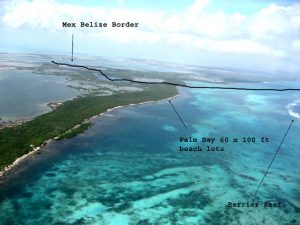I am only doing a write up on Bacalar Chico Marine Reserve being it is a “marine reserve”, but this is one marine reserve with which the yachts have never ever before had any contact or interest.
Bacalar Chico was established in 1996. Encompassing an area of 41 square miles.
Bacalar Chico is bounded on the north by the Belize/Mexico border and the channel. It borders Mexico along with associated reef tract on the east and an area of the Chetumal Bay on the west and a southern boundary marked by the point from San Juan to Robles Point, including a portion of Chetumal Bay and a little beyond the reef. The towns of Corozal, San Pedro, and Sarteneja are cooperatively involved.
It is a part of the Belize Barrier Reef Reserve System, which nominated in 1996 as a World Heritage Site under the UNESCO World Heritage Convention. It is managed by the Fisheries and Forest Departments.
Accesible only by sea, Bacalar Chico Marine and Wildlife Reserve, is at the northern tip of Ambergris Caye overlooking the Bay of Chetumal and Mexico. The ranger station is located amidst the ruins of Chac Balam, which was an important Maya trading center. Fifteen hundred years ago these same Maya cut the narrow channel that separates Ambergris Caye from Mexico’s Yucatan Peninsula.
The region encompasses intraisland lagoons, mud flats, sink holes, mangroves forests, savannahs, semideciduous forest and is home to many different animals. There are about eight different Mayan sites in the Bacalar Chico area two of which, San Juan and Chac- balam) have been partially excavated and have been made somewhat accessible by trails.
To our knowledge very few divers visit the area, but we understand that the diving opportunities are spectacular. Tours to Bacalar Chico can be arranged through local tour guides. Dress lightly, wear a bathing suit, repellant and/or sunscreen, comfortable shoes or sandals, sunglasses, and a hat.
The Bacalar Chico Project is geared toward sustainable use and development of this unique area of North Ambergris Caye due to a variety of exceptional factors: at Rocky Point the reef touches the shore; the green sea turtle and the loggerhead nesting site between Robles and Rocky Point; the offshore marine habitat once known as a breeding area for Queen conch; and the seasonal spawning bank for the nassau and yellow fin groupers; the high diversity of terrestrial and vegatation zones.
A ranger station and visitors center has been established about a mile from the border. Rangers can advise to the closed fishing areas. The new reserve is diverse. It is home to seven Maya sites of which only one has been excavated, the puma and jaguar (both endangered species), and an abundance of flora and fauna.
